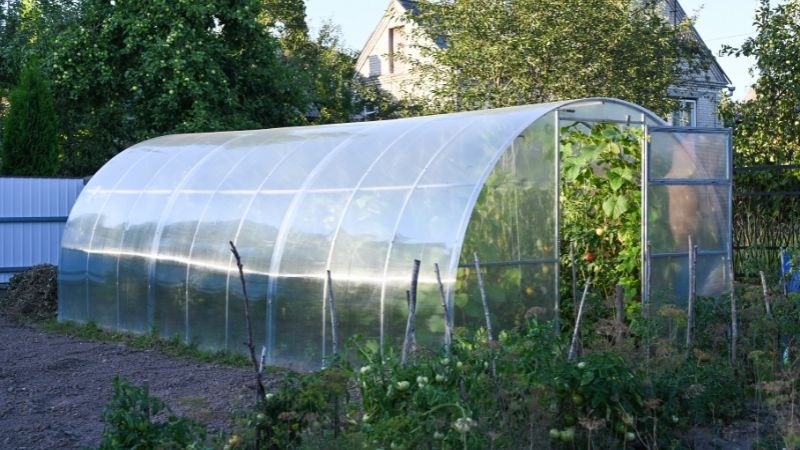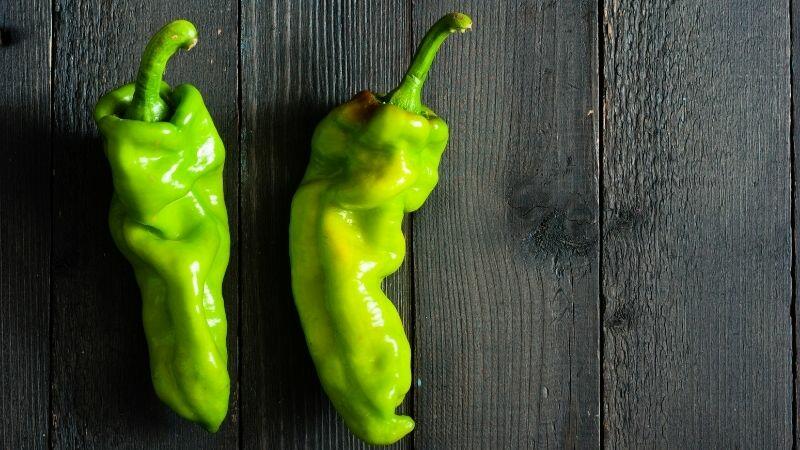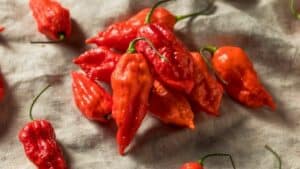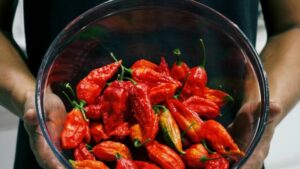You went out to your garden expecting to harvest ripe red ghost peppers, only to find they’re still green. Should you pick them anyway? Are green ghost peppers spicy enough to cook with?
Ghost peppers are still hot in their green, unripe state. However, they are not at their hottest because they are yet to fully produce their phytochemical, ‘Capsaicin’, and evenly distribute it through the pepper. They instead have a grassy flavor added to their mild hotness, making them suitable for salads.
While not as fiery as fully ripe red ghosts, green ones still bring substantial heat. Their milder smolder and fresh flavor makes green ghosts perfect for salsa, stir fries, and eating raw.
In this article, we’ll explore:
- The Scoville rating for green ghost peppers
- Benefits of using green vs red ghost peppers
- How to grow vibrant multi-colored ghost peppers
- FAQs on harvesting and storing green ghosts
So don’t let the green color fool you. These mini firecrackers can set your mouth ablaze! Let’s take a closer look at green ghost peppers.
How Hot Are Green Ghost Peppers?
The ghost pepper is one of the world’s hottest chilies. This scorcher from India is known by many names, like bhut jolokia and naga jolokia.
In 2007, the ghost pepper smashed records by registering over 1 million Scoville Heat Units (SHU) on the
Traditionally, ripe ghost peppers are red. But before turning red, they go through several color phases:
- Green
- Yellow
- Orange
- Red
- Purple
Green ghost peppers aren’t as fiery as ripe red ones, but they still pack significant heat.
On the Scoville scale, most sources peg green ghosts between 100,000 to 350,000 SHU. That’s many times hotter than a jalapeño at just 3,500 to 10,000 SHU!
So while green ghosts aren’t at their maximum spiciness, they’re nowhere near mild. Their heat builds slowly, starting like a faint glow before erupting into a raging flame.
Ripe red ghost peppers clock in around 1 million SHU because their capsaicin content is fully developed. Green ones are spicy, just not face-meltingly so.
Why Eat Green Ghost Peppers?
Wondering if it’s worth using green ghost peppers? Here are some benefits:
More Peppers Per Plant
Harvesting green ghosts means more peppers per plant. Waiting for full red maturity yields higher heat but fewer fruits.
Great Raw Flavor
Green ghost peppers have a fresh, grassy taste perfect for salsa and salads. Their milder spiciness works better raw.
Gradual Burn
The slow heat build of green ghosts is great for people new to extreme chilies. It’s a more palatable introduction to superhots.
Cooler Dishes
With lower heat, green ghosts won’t overwhelm delicate recipes. Their mellower fire adds a perfect pop.
Ripen Anytime
Picked green ghosts can be left to ripen until red. Enjoy the flexibility of harvesting now or later.
So don’t toss those green ghost peppers! Use their distinct flavor and moderate burn to add intrigue to your cooking.
Why Are My Green Ghost Peppers Not Hot, What Factors Are Responsible?
All chili peppers have their heat deeply ingrained within the membranes of the fruit and seeds. As a result, whether ripe or unripe, your ghost peppers should exhibit that characteristic heat quality.
Although you would generally expect less heat from any green pepper, or ghost peppers, they retain their heat, except mildly and laced with the immature, unripe grassy flavor. Several factors contribute to your green ghost peppers losing their heat when fresh from the stalk.
There are chances that the absent heat might be due to a combination of some initial planting factors. Here are some of them.
Reasons Why Your Green Ghost Peppers Might Not Be Hot
Poor Soil Quality

The quality of your soil can significantly impact the spiciness of your ghost peppers. You should aim for soil that is rich in essential nutrients and minerals, especially sulfur. Sulfur is an essential contributing factor to pepper capsaicin. Also, your planting soils must be well aerated and easy to till to enable your ghost pepper seeds to develop solid rooting during the seeding process.
Poor Garden Siteing

Ghost peppers are usually free to interbreed. However because ghost peppers are an already existing hybrid, you might want to take precautions to preserve the purity of their breed. You can control interbreeding by ensuring that you do not allow your ghost peppers to grow around other sweeter peppers to avoid a tendency of your growing plants to further interbreed.
Seeds With Poor Viability
Your seed viability is critical to getting true ghost peppers at maturity. It is best to taste the seeds before buying or get an initial quantity for cooking to ascertain the hotness of the pepper seeds before buying. You should also ensure that you get your seed supply from a reputable vendor. For instance, Ohio Heirloom seeds offer viable ghost pepper sees at $5.49.
Poor Cultivation Practices
Poor cultivation practices like overwatering, and over fertilizing can affect the outcome of your ghost peppers when they start fruiting, causing a dilution of the soil’s sulfur content and fruit capsicum and capsaicin content. Most hot peppers like those from the chili family require significant heat, sunlight, and a reasonable water supply to thrive.
It is the reason why ghost peppers thrive in Northeast India, where the climate is hotter. If you have to grow ghost peppers in temperate regions, you should begin cultivation indoors, away from the risk of frost and lower temperatures.
Growing Perfectly Fiery Ghost Peppers
For the best harvest of green and red ghost peppers, follow these tips:
- Plant in warm weather after the last frost. Ghost peppers thrive in heat.
- Choose a sunny spot with fertile, well-draining soil.
- Fertilize with a vegetable or pepper formula every 2-3 weeks.
- Water 1-2 inches per week. Too much water dilutes heat.
- Monitor for pests and diseases. Treat problems ASAP.
- Stake plants for support once they reach 12 inches tall.
- Pick peppers once glossy and firm to the touch.
With proper care, your ghost pepper plants will reward you with baskets of gorgeous green and crimson fruits bursting with flavor.
Below is a table showing some additional information you might need before planting a ghost pepper garden.
| Scientific Name | Bhut jolokia |
| General Name | Ghost peppers |
| Geographical History | Native to Northeast India |
| Scoville Heat Units | 850,000 to 1,041,427 SHU |
| Median Heat Units | 948,214 SHU |
| Jalapeno Pepper Reference Point | 107 to 417 times hotter |
| Specie variations | Yellow, orange, chocolate, purple, peach, and white ghost peppers |
| Breeding profile | Hybrid Chili (Capsicum chinense x Capsicum frutescens) |
| Growth height | 1.22 meters high |
| Dominant Seasonal Availability | Summer through Fall |
| Flavor | Ghost peppers possess an intense heat with a sweet fruity flavor beneath. The heat takes about 30 to 45 seconds to build up and may last for about 10 to 15 minutes. The pepper burn takes about 30 to 45 minutes to subside. |
| Purchase weight per bushel | 25 to 30lbs per bushel |
| Average price per plantable seed supply | $5.49 to $20 depending on vendor and quantity. |
| Nutritional Value | Antioxidants |
Frequently Asked Questions
Are Green Ghost Peppers Spicy?
Green ghost peppers are mildly hot and therefore possess less spiciness compared to their red counterparts. The reason is that they contain less capsaicin and instead have a green, grassy flavor that makes them a salad and other raw recipe favorites. However, they are way spicier than bell peppers.
Will Harvesting Ghost Peppers While Green Make More Grow?
Harvesting ghost peppers while green will cause the plant to produce more fruits. Essentially, it means picking them in their premature state which you can keep later to ripen. Picking green, unripe ghost peppers gives you more harvest while picking them ripe and orange or red leave you with a few.
Why Are My Ghost Chili Peppers Not Hot?
When ghost chilis and all chilis, in general, fail to attain hotness, it could be due to several planting factors. Examples of such factors include but are not limited to poor soil, wrong garden site, ghost pepper seed variety, poor cultivation practices, etc.
Are green ghost peppers edible?
Yes! Green ghosts offer a more delicate heat perfect for salsa, stir fries, and more raw uses.
What’s the Scoville rating for green ghost peppers?
Around 100,000 to 350,000 SHU, compared to a jalapeño’s 3,500 to 10,000 SHU. Green ghosts pack serious heat!
Should I refrigerate green ghost peppers?
Yes. Store harvested green ghosts in the fridge in a loose plastic bag for 1-2 weeks max.
Can you freeze green ghost peppers?
Absolutely! Blanch in boiling water for 3 minutes, then freeze in a single layer on a sheet pan before transferring to a freezer bag.
What’s better – green vs red ghost peppers?
It depends on your taste! Green offers milder heat and fruity flavor. Red brings the full fireworks. Enjoy both!
Turn Up The Heat With Ghost Peppers
Ghost peppers
Green ghosts may seem too unripe to handle the heat, but these mini firecrackers still pack a mighty punch. Add their mellower smolder to balance flavors and bring new life to your favorite recipes.
Just be ready with plenty of milk and bread – because ghost peppers, no matter the color, aren’t for the faint of heart!





